最近之前的uwb引擎还要重构在发一下 uwb相关的东西吧
UWB属于IEEE 802.15.4技术体系,与3GPP LTE/NR技术体系的定义方式有一些区别,但是基本原理是一样的。
在通信系统中,首先需要作时频同步,然后需要作帧同步,然后在PHY中需要有控制信道,同时有数据信道。在UWB中,SYNC用于时频同步、AGC、分集选择等功能,而SFD用于帧同步(特殊序列),PHR用于控制信息,PHY Payload用于传输实际的数据。

鉴于SYNC,SFD,PHR,DATA字段承担的角色不同,所以,每个字段的信号调制编码方式是有很大差异的。
SYNC构成方式:三个步骤,一个是扩频,然后是冲击脉冲替代,之后是重复再扩展。一个符号Si,首先用Ci序列扩展成长度为31/127的扩频序列,每个码元再用长度为L(16/64/4)的序列进行扩展,接着再进行重复(16/64/1024/4096,可配置)。典型值:Ci序列长度为31,冲击扩展长度为16,重复扩展为64。
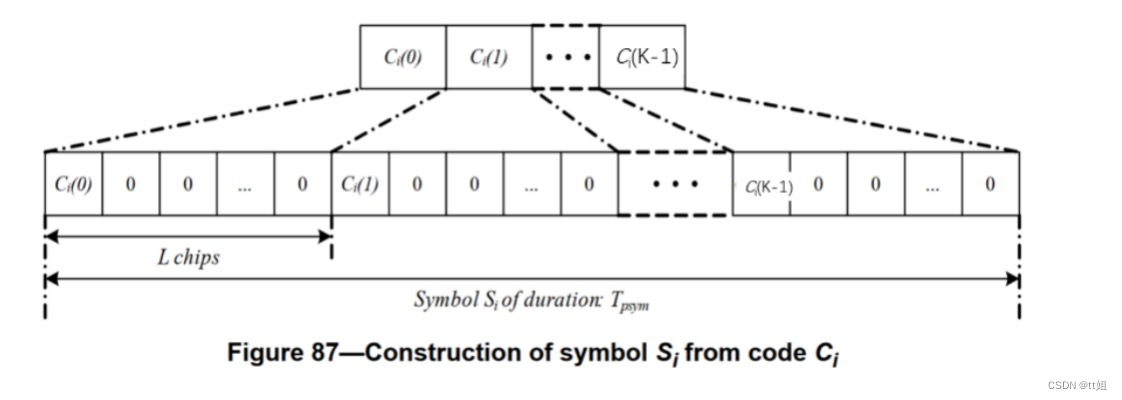
SFD构成方式:前两步与SYNC构成方式相同,第三步的时候有点差异,一个是重复次数SFD是8/64(默认用8,110K时可以用64),另一个是由于SFD是用于确定帧结构边界的,所以必须有特征,这是通过在每次重复时乘以不同的码来实现的。An SFD shall be added to establish frame timing. The UWB PHY uses a short SFD for default and medium data rates and a long SFD for the optional low data rate of 110 kb/s as shown in Figure 86. The short SFD shall be [0 +1 0 –1 +1 0 0 –1] spread by the preamble symbol Si, where the leftmost bit shall be transmitted first in time. The long SFD shall be obtained by spreading the sequence [0 +1 0 –1 +1 0 0 –1 0 +1 0 –1 +1 0 0 –1 –1 0 0 +1 0 –1 0 +1 0 +1 0 0 0 –1 0 –1 0 –1 0 0 +1 0 –1 –1 0 –1 +1 0 0 0 0 +1 +1 0 0 –1 –1 –1 +1 –1 +1 +1 0 0 0 0 +1 +1] by the preamble symbol Si. Note that the long SFD is eight times longer than the short SFD and consists of 64 preamble symbols, only 32 of which are active, and the other 32 are zeros.
需要注意的是,对于preamble而言,一个符号Si就是Ci扩频后再经过delta函数扩展的结果,而之后的重复过程是针对符号重复形成preamble/SHR块。

对于preamble来讲,符号是连续的,499.2/31 = 16.1M,为什么preamble的peak PRF和mean PRF是31.2M和16.1M,建议后面再研究一下。此处能看见的是针对典型配置,一个preamble符号持续时间是1us左右。
UWB物理层与帧相关的参数如下:

对于PHR和Payload/Data的处理,则会涉及到编码、调制等问题。
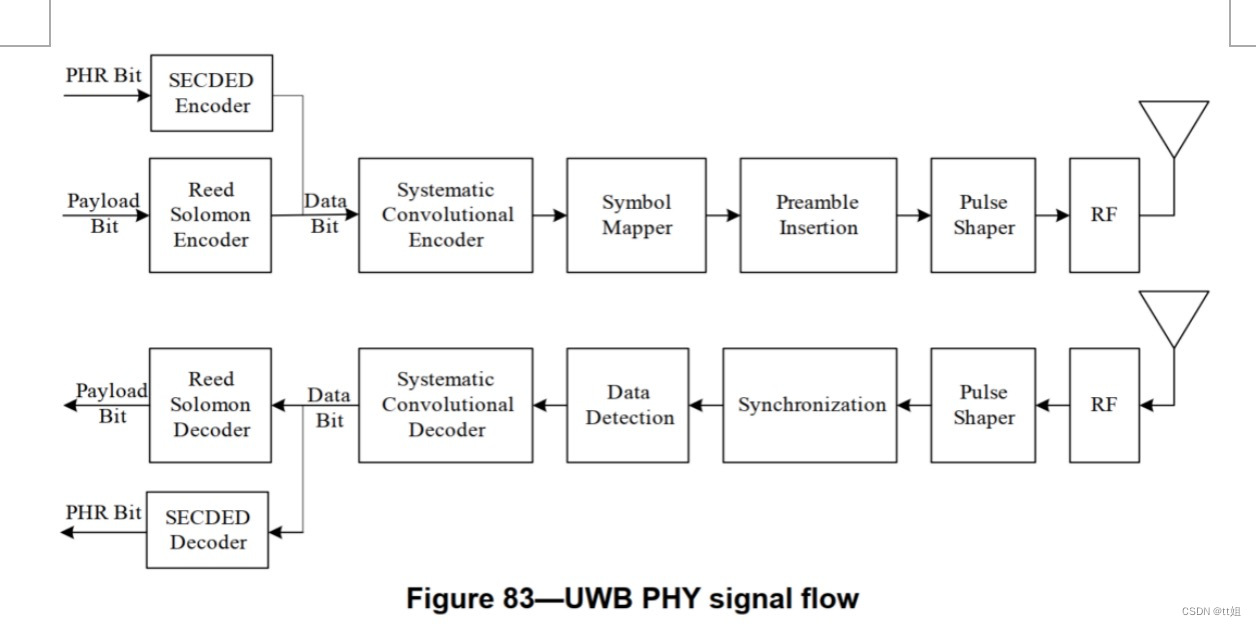
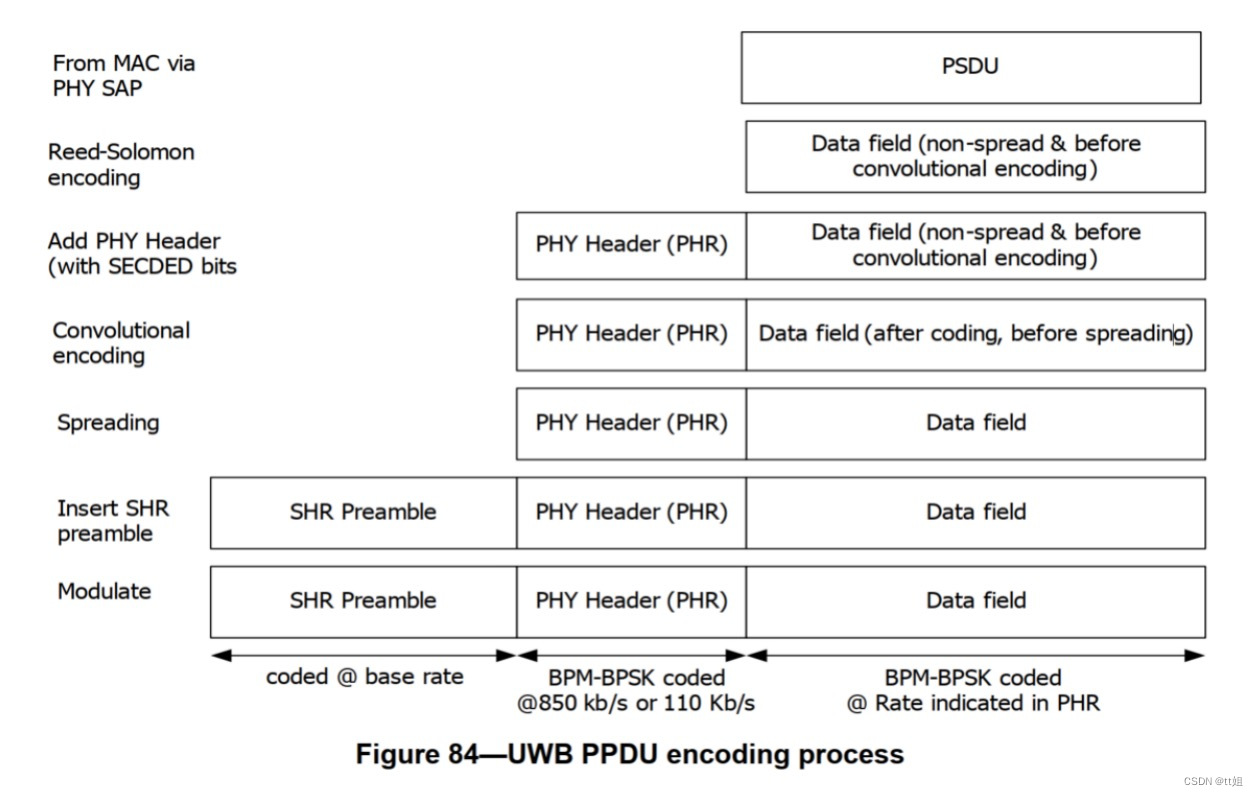
在UWB中,采取的是级联编码的方式,第一级是SECDED/RS编码,第二级是1/2卷积编码。对于PHR bit,采用的是SECDED+卷积码;对于Payload,采用的是RS编码+卷积码。
UWB采取的调制方式是BPM-BPSK调制的结合。在一个符号时间分成两个部分,其中一个比特可用于选择是前半部分还是后半部分,这是BPM调制;另一个比特用于确定Burst的相位,采取BPSK方式。
简单组合应该按如下图所示:
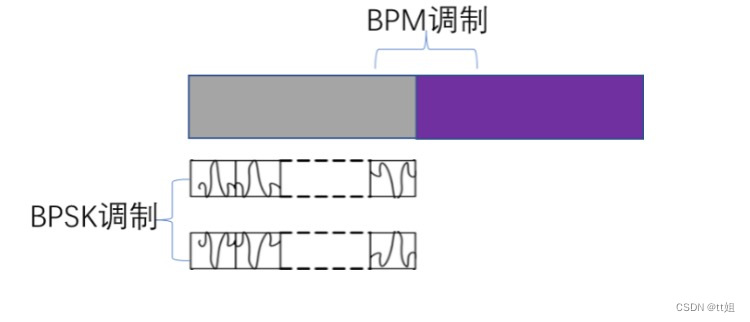
但在实际实施过程中,为了避免符号间干扰,两个BPM位置之间需要加入Guard Interval,同时在一个BPM位置内部,为了降低多用户之间的干扰,将一个BPM位置划分成若干个可能位置(Nhop个),这样不同用户随机选择这些时间上的burst,就实现了干扰随机化。(In each UWB PHY symbol interval, a single burst event shall be transmitted. The fact that burst duration is
typically much shorter than the BPM duration, i.e., Tburst << TBPM, provides for some multi-user access
interference rejection in the form of time hopping. The total number of burst durations per symbol, Nburst, is given by Nburst = Tdsym /Tburst. In order to limit the amount of inter-symbol interference caused by multipath, only the first half of each TBPM period shall contain a burst. Therefore, only the first Nhop= Nburst/4 possible burst positions are candidate hopping burst positions within each BPM interval. Each burst position can be varied on a symbol-to-symbol basis according to a time hopping code)

802.15.4-2011规定的UWB信道编号如下:

对于PHY/Payload而言,peak PRF是499.2MHz,而mean PRF定义为Ncpb/Tsym = Ncpb/(Ncpsym*Tc) = (Ncpb/Ncpsm)*(1/Tc),即meanPRF表示了burst在总的符号时间中的占比,或者说体现了burst的PRF。
Within each UWB channel {0:15}, the peak PRF shall be 499.2 MHz. This rate corresponds to the highest
frequency at which a compliant transmitter shall emit pulses. Additionally, the mean PRF is defined as the total number of pulses emitted during a symbol period divided by the length of the symbol duration. During the SHR preamble portion of a UWB frame, the peak and mean PRFs are essentially the same since pulses are emitted uniformly during each preamble symbol. During the data portion of a PPDU, however, the peak and mean PRFs differ due to the grouping of pulses into consecutive chip durations.
以下表第一行的配置为例,在一个符号内部,Nburst始终是32,Nhop始终是8,不同速率是通过每个burst占据不同时间(不同的chip数)来实现的。Chip数的不同,其实就代表了payload/data部分的扩频系数的差异,110k、850k、6.8M对应的码片数分别为128、16、2,对应符号持续时间分别是8.2us、1.0us、128ns,一个burst固定承载的比特数为2比特。
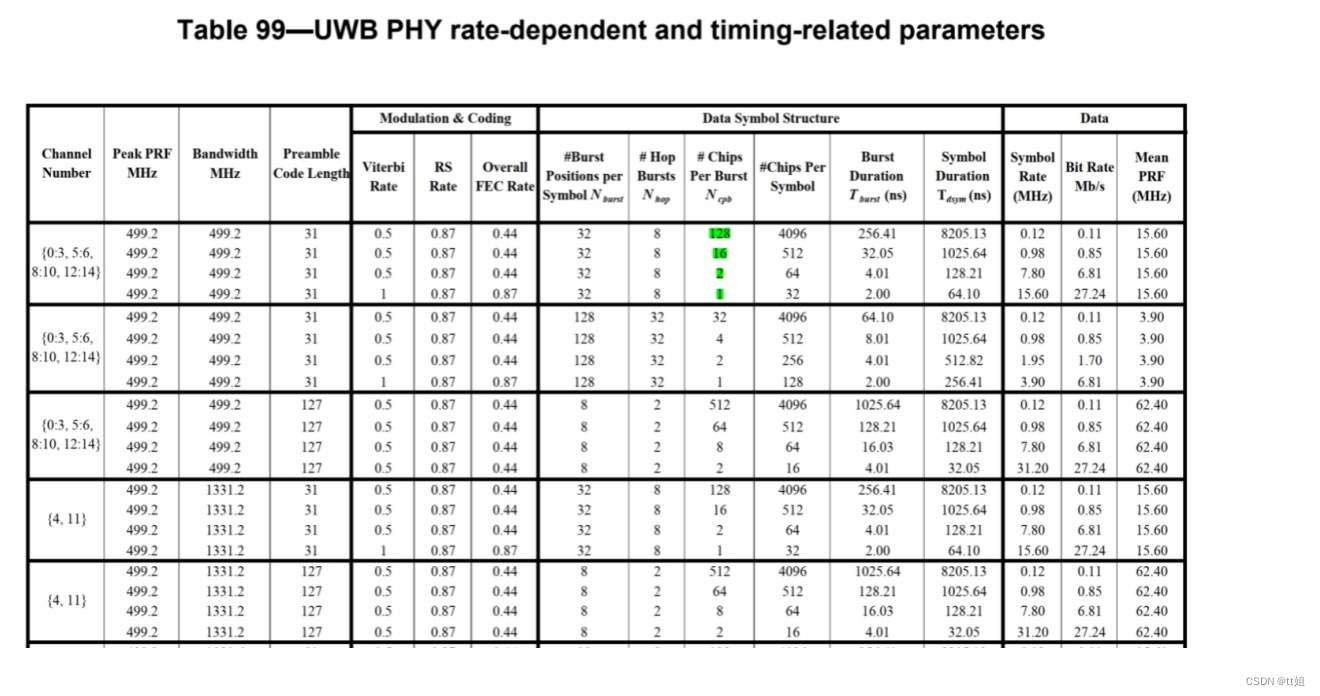
The peak PRF states the highest frequency in megahertz at which a compliant transmitter shall emit pulses. The peak PRF is also used to derive the chip duration Tc by the formula Tc = 1/(peakPRF). The value of Tc is approximately 2 ns. The bandwidth denotes the 3 dB bandwidth of the UWB pulses. Note that the bandwidth is not necessarily the inverse of the chip duration Tc.[脉冲对应的带宽与脉冲形状密切相关]
上表中的各个参数的含义如下:
- The overall FEC rate is determined by the product of the Viterbi rate and the Reed-Solomon rate and has either a value of 0.44 or 0.87.
- The burst positions per symbol parameter is the total number of possible burst positions in a data symbol duration. Nburst has been chosen so that for each mean PRF a data symbol consists of a fixed number of burst durations.
- The hop bursts parameter is the number of burst positions that may contain an active burst, that is, a burst containing UWB pulses. The value is computed as Nhop = Nburst/4.
- The chips per burst parameter is the number of chip Tc durations within each burst period Tburst. Each burst consists of a multiple number of consecutive chips, as illustrated in Figure 85. Depending on the data rate to be used in the transmission of the PSDU, the number of chips in a burst varies, e.g., for low data rates, the burst consists of more chip periods than for high data rates. Particular, values of Ncpb have been selected so that the following is a valid data rate: (2 × Overall FEC Rate)/(Ncpb × Nburst × Tc).
- The burst duration parameter is simply the duration of a burst and is computed as Tburst = Ncpb × Tc.
- The symbol duration parameter is a the duration of a modulated and coded PSDU symbol on the air and is computed as follows: Tdsym = Nburst × Tburst.
- The symbol rate parameter is the inverse of the PSDU symbol duration 1/Tdsym.
- The bit rate parameter is the user information rate considering FEC and is computed as follows:
Bit Rate = 2 × (Overall FEC Rate)/Tdsym - The mean PRF parameter is the average PRF during the PSDU portion of a PHY frame and is computed as follows: Mean PRF = Ncpb/Tdsym
whaosoft aiot http://143ai.com
PHR格式如下:

Preamble Duration定义如下:

Nominal data rate定义如下:

SECDED比特采用Hamming码(single error correct,double error detect)。
数据域处理方式:

UWB数据的发送波形定义方式如下:
The time-varying spreader sequence and the time-varying burst hopping sequence shall be
generated from a common PRBS scrambler。比如有128个码片,则是128个加扰脉冲的叠加。

UWB PHY FEC编码方式如下:RS编码添加48比特的奇偶校验码,后面再经过1/2的卷积编码。

成型函数p(t)波形如下所示:

从可靠性角度考虑:需要SYNCàSFDàPHRàPayload逐级保证,对于SYNC和SFD而言,应该是通过码来提升性能,SYNC可采用16/64/1024/4096,而SFD可采用8/64,PHR/Payload采用128/16/2码片长度(110k/850k/6.8M,对应一个符号8us/1us/128ns)。对于UWB系统,一定成都上是一个宽带扩频系统,其性能不应该主要通过功率来提升。
如果SYNC采用64,则对应64us,如果SFD也是64,则也是64us,两个加起来对应128us。对于PHR 19比特,如果采用850kbps传输,对应时间1us*19 = 19us,如果是110kbps,则对应8us*19 = 152us。对于127byte的数据,对应127*8 = 1016bit,采用6.8M对应128us,采用850kbps则对应1016*1us = 1ms左右,而之前按照6.8M工作时的时隙划分是500us,也就是说6.8M的时隙划分不适用于850kbps,必须修订。
为什么定义必须要承载127byte这么大的数据量?这么大的数据量会导致系统容量大幅缩减。
必须将SYNC,SFD,PHR,Payload对应的格式、编码、长度等搞清楚,这样才能有效对系统参数进行规划。